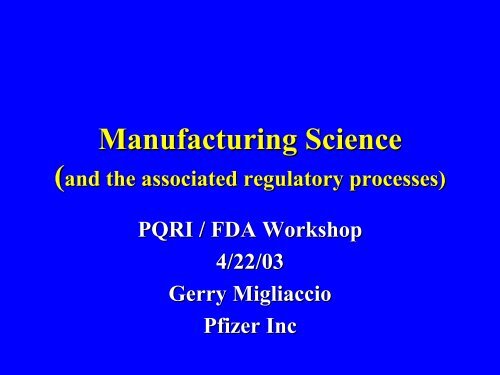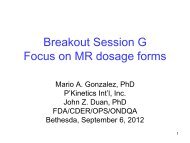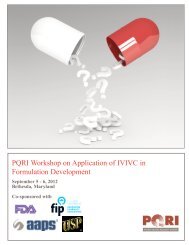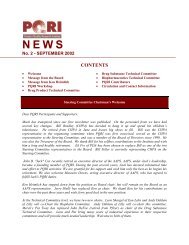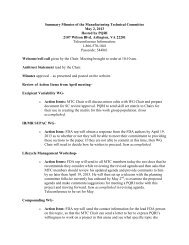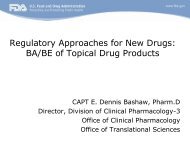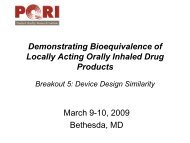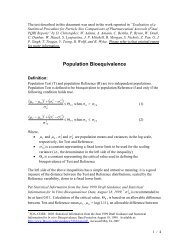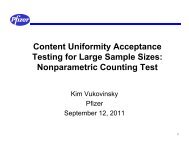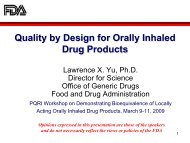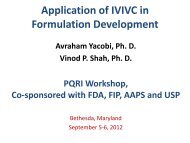Manufacturing Science (PDF) - PQRI
Manufacturing Science (PDF) - PQRI
Manufacturing Science (PDF) - PQRI
You also want an ePaper? Increase the reach of your titles
YUMPU automatically turns print PDFs into web optimized ePapers that Google loves.
<strong>Manufacturing</strong> <strong>Science</strong>(and and the associated regulatory processes)<strong>PQRI</strong> / FDA Workshop4/22/03Gerry MigliaccioPfizer Inc
Objective• Provide seeds for tomorrow’s workshopon the desired relationship betweenmanufacturing science and relatedregulatory processes.– Desired state should accommodate the needsall segments of industry and FDA.– Desired state should allow flexibility.– Desired state should encourage and facilitateinnovation but not penalize status quo.
<strong>Manufacturing</strong> <strong>Science</strong>Definition• Consists of Five Elements– Product / Process Knowledge– Process Capability Data– <strong>Manufacturing</strong> Technology– Process Control Technology– Quality Systems Infrastructure
Product / Process Knowledge (K)• Development pharmaceutics• Critical to quality attributes offormulation• Critical to quality process parameters• Critical to quality product attributes• Impact of changes to critical to qualityparameters and attributes
Process Capability (CP K )• Data analysis of critical to qualityparameters and attributes.• Assessment of actual performance versusoriginal specifications.• Continuous trending.
<strong>Manufacturing</strong> Technology (T)• Equipment design and principles ofoperation• Facility design• Level of manual intervention versusautomation• Cleanability, , potential for cross-contamination
Process Control Technology (PC)• Instrumentation and sensors• Monitoring and reactive control versuscontinuous feedback loops• Remote versus at-line or on-line• Conventional versus process analyticaltechnologies• Traditional validation versus continuousquality verification
Quality Systems (QS)• cGMP Infrastructure at <strong>Manufacturing</strong>Site• Regulatory Inspection Performance• Recall Record
The FormulaeRisk ƒ (K, CP k , T, PC, QS)∴↑ <strong>Manufacturing</strong> <strong>Science</strong> ≡ ↓ RiskandRegulatory Process ∝ Risk
<strong>Manufacturing</strong> <strong>Science</strong> andRisk• Product / process knowledge will provideus with an initial assessment of the risk ofa quality issue.– What is the impact of deviations in level offormulation components on fitness-forfor-use?– What is the impact of deviations in critical-to-quality parameters on fitness-forfor-use?
<strong>Manufacturing</strong> <strong>Science</strong> andRisk• Process capability analysis will provideus with an assessment of:– Process variability and need for furtherprocess optimization– Ability to meet quality attributes required toassure safety and efficacy 100% of the time.
<strong>Manufacturing</strong> <strong>Science</strong> andRisk• Product /process knowledge coupled withprocess capability analysis allow us tocategorize the risk associated with agiven process.• Since knowledge is continuously obtainedand capability continuously analyzed, therisk classification can change over time.
<strong>Manufacturing</strong> <strong>Science</strong> andRisk• <strong>Manufacturing</strong> and Process ControlTechnology can be used to mitigate therisk associated with a process.– Process capability / robustness issues can beaddressed through the use of innovativemanufacturing technologies and processcontrols.
Regulatory Processes and Risk• Regulatory processes should beproportional to the level of risk.– Routine cGMP inspection frequency– Need for PAI’s– NDA content and approval process– Supplement content and approvalrequirements– Comparability protocols
The FormulaeRisk ƒ (K, CP k , T, PC, QS)∴↑ <strong>Manufacturing</strong> <strong>Science</strong> ≡ ↓ RiskandRegulatory Process ∝ RiskGreat concept, but how to we get there?
Key Units of Work• Define the data set required for FDA andIndustry to appropriately categorize risk.– Critical to quality attributes and parameters– CP K data• Development of an agreement betweenFDA and Industry on the use oftechnology to mitigate risk.
Key Success Factors• Firms must be willing to shareappropriate data with FDA.• FDA must demonstrate to firms whoinvest in technology that the regulatoryprocesses will allow for greater flexibility.• Firms who decide to proceed withcurrent approach should not bepenalized.


